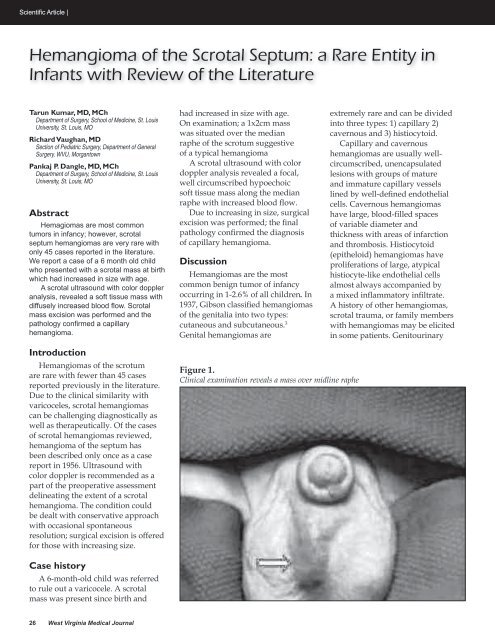Adam E. Klein, MD - West Virginia State Medical Association
Adam E. Klein, MD - West Virginia State Medical Association
Adam E. Klein, MD - West Virginia State Medical Association
You also want an ePaper? Increase the reach of your titles
YUMPU automatically turns print PDFs into web optimized ePapers that Google loves.
Scientific Article |Hemangioma of the Scrotal Septum: a Rare Entity inInfants with Review of the LiteratureTarun Kumar, <strong>MD</strong>, MChDepartment of Surgery, School of Medicine, St. LouisUniversity, St. Louis, MORichard Vaughan, <strong>MD</strong>Section of Pediatric Surgery, Department of GeneralSurgery, WVU, MorgantownPankaj P. Dangle, <strong>MD</strong>, MChDepartment of Surgery, School of Medicine, St. LouisUniversity, St. Louis, MOAbstractHemagiomas are most commontumors in infancy; however, scrotalseptum hemangiomas are very rare withonly 45 cases reported in the literature.We report a case of a 6 month old childwho presented with a scrotal mass at birthwhich had increased in size with age.A scrotal ultrasound with color doppleranalysis, revealed a soft tissue mass withdiffusely increased blood flow. Scrotalmass excision was performed and thepathology confirmed a capillaryhemangioma.had increased in size with age.On examination; a 1x2cm masswas situated over the medianraphe of the scrotum suggestiveof a typical hemangiomaA scrotal ultrasound with colordoppler analysis revealed a focal,well circumscribed hypoechoicsoft tissue mass along the medianraphe with increased blood flow.Due to increasing in size, surgicalexcision was performed; the finalpathology confirmed the diagnosisof capillary hemangioma.DiscussionHemangiomas are the mostcommon benign tumor of infancyoccurring in 1-2.6% of all children. In1937, Gibson classified hemangiomasof the genitalia into two types:cutaneous and subcutaneous. 3Genital hemangiomas areextremely rare and can be dividedinto three types: 1) capillary 2)cavernous and 3) histiocytoid.Capillary and cavernoushemangiomas are usually wellcircumscribed,unencapsulatedlesions with groups of matureand immature capillary vesselslined by well-defined endothelialcells. Cavernous hemangiomashave large, blood-filled spacesof variable diameter andthickness with areas of infarctionand thrombosis. Histiocytoid(epitheloid) hemangiomas haveproliferations of large, atypicalhistiocyte-like endothelial cellsalmost always accompanied bya mixed inflammatory infiltrate.A history of other hemangiomas,scrotal trauma, or family memberswith hemangiomas may be elicitedin some patients. GenitourinaryIntroductionHemangiomas of the scrotumare rare with fewer than 45 casesreported previously in the literature.Due to the clinical similarity withvaricoceles, scrotal hemangiomascan be challenging diagnostically aswell as therapeutically. Of the casesof scrotal hemangiomas reviewed,hemangioma of the septum hasbeen described only once as a casereport in 1956. Ultrasound withcolor doppler is recommended as apart of the preoperative assessmentdelineating the extent of a scrotalhemangioma. The condition couldbe dealt with conservative approachwith occasional spontaneousresolution; surgical excision is offeredfor those with increasing size.Figure 1.Clinical examination reveals a mass over midline rapheCase historyA 6-month-old child was referredto rule out a varicocele. A scrotalmass was present since birth and26 <strong>West</strong> <strong>Virginia</strong> <strong>Medical</strong> Journal















